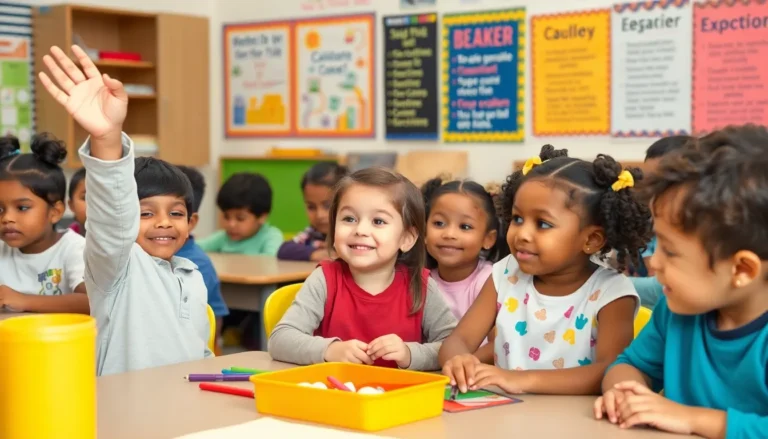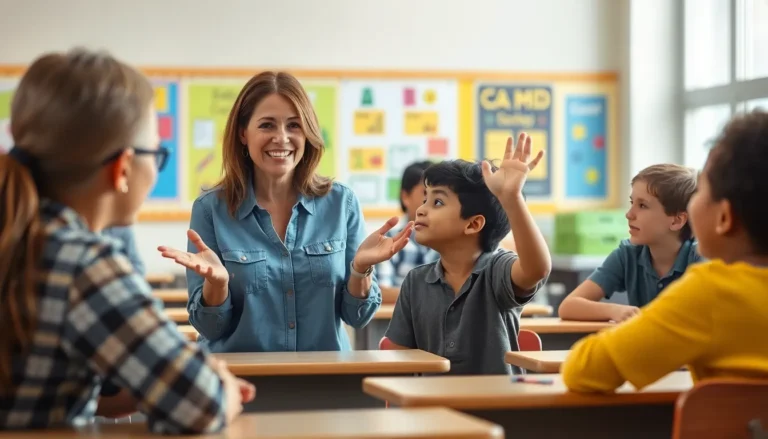Table of Contents
ToggleIn the bustling world of elementary classrooms, a little structure goes a long way. Imagine a place where kids can learn, laugh, and maybe even trade their lunch snacks without chaos erupting. Classroom rules and regulations are the secret sauce that keeps this delicate balance intact. They’re not just a list of “don’ts” but a roadmap to a fun and productive learning environment.
When students understand the expectations, they thrive. Rules like “raise your hand to speak” or “keep your hands to yourself” might sound mundane, but they’re the building blocks of a respectful community. So let’s dive into how these guidelines not only keep the peace but also help young minds flourish while having a blast. After all, who says learning can’t be a little bit of fun?
Importance of Classroom Rules and Regulations
Classroom rules and regulations create a structured environment crucial for elementary pupils. Such an environment fosters positive interactions among students, enhancing collaboration and respect. Students understand expectations through clear guidelines like raising hands to speak or keeping hands to oneself.
Regulations maintain order, which directly impacts the learning experience. When pupils follow rules, distractions decrease, allowing more focus on educational activities. Teachers can effectively manage classrooms, ensuring all students engage fully with the lessons.
Respect forms a critical component within these rules. Encouraging respectful behavior helps students build strong relationships with peers and teachers. Moreover, learning in a respectful space supports social development, preparing pupils for future interactions.
Positive behavior cultivates a sense of community among students. Following guidelines fosters cooperation, promoting teamwork and mutual support. Engagement often increases when students feel safe and valued in their classrooms.
Understanding classroom rules nurtures responsibility among pupils. Students who grasp the significance of these regulations take ownership of their actions. This leads to increased accountability, not just for themselves but also for the collective classroom environment.
Ultimately, effective classroom rules and regulations enhance the overall educational experience. Prioritizing clear expectations helps establish a supportive and productive atmosphere for learning. As a result, elementary pupils thrive academically and socially within their school communities.
Common Classroom Rules
Classroom rules guide students in creating a productive learning environment. Each rule supports a structure that encourages respect and positive interactions.
Respect and Cooperation
Respect fosters a harmonious classroom. Students treat each other and teachers kindly, which builds strong relationships. Cooperation enhances teamwork, allowing students to work well together. Sharing materials and assisting peers strengthen community bonds. Listening attentively during discussions promotes a respectful atmosphere. Acknowledging others’ opinions encourages open communication. When students practice respect, they create a supportive environment conducive to learning.
Active Participation
Active participation engages students in their learning process. Teachers encourage raising hands before speaking to promote orderly communication. All students benefit from sharing ideas, as it enriches classroom discussions. Completing assignments on time demonstrates responsibility and commitment to learning. Group work allows students to contribute equally, enhancing collaboration skills. Participation also includes asking questions to clarify understanding. Encouraging every student to contribute helps maintain interest and enthusiasm in the classroom.
Classroom Safety
Classroom safety protects all students and staff. Following rules regarding personal space minimizes risk of injury. Keeping the area clean prevents accidents and maintains a pleasant environment. In case of emergencies, knowing safety procedures ensures preparedness. Students must remain seated during lessons unless given permission to move. Reporting unsafe conditions to teachers is essential for maintaining safety. Emphasizing safety creates a secure space where students can focus on learning without fear or disruption.
Creating Effective Rules
Classroom rules thrive when students actively participate in their creation. Involving students helps them understand the importance of the rules and fosters a sense of ownership. Engaging them in discussions around what rules should be included can lead to more respectful and cooperative behavior. Teachers can facilitate brainstorming sessions, allowing students to voice their ideas. This collaborative approach ensures that rules resonate with students, enhancing compliance.
Clear communication of expectations is vital to ensuring rules are understood and followed. Teachers should articulate guidelines in simple and straightforward terms, avoiding jargon. Visual aids like posters can reinforce these expectations and serve as constant reminders. Regularly reviewing rules helps maintain awareness and clarity. Furthermore, feedback sessions allow students to ask questions and express concerns. Such dialogues enhance understanding and promote an environment of trust, making compliance more likely.
Enforcing Rules Consistently
Enforcing classroom rules consistently establishes a dependable environment for elementary pupils. Consistent implementation of these rules reinforces their importance.
Positive Reinforcement Strategies
Positive reinforcement encourages students to follow rules and engage in appropriate behavior. Praise and rewards boost motivation and build a supportive classroom atmosphere. Offering small incentives, such as extra recess time or class privileges, enhances compliance and promotes overall discipline. Displaying student achievements acknowledges their contributions and reinforces desired behaviors. Regularly acknowledging cooperation fosters a sense of community, encouraging peers to follow suit.
Addressing Rule Violations
Addressing rule violations promptly ensures that students understand expectations. Establishing clear consequences for disruptive behavior maintains order and prevents future occurrences. Providing constructive feedback helps students learn from mistakes and offers guidance for improvement. Communicating with parents about repeated issues fosters collaboration and supports student development. Ensuring all students understand the rationale behind consequences enhances accountability and responsibility. Regular discussions help maintain awareness and build trust among students and teachers.
Classroom rules and regulations are vital in shaping a positive learning environment for elementary pupils. They not only promote respect and cooperation but also enhance students’ social development. By involving students in the creation of these rules teachers can foster a sense of ownership that encourages adherence and accountability.
Consistent enforcement and clear communication of expectations further contribute to a structured atmosphere where students can thrive. Positive reinforcement strategies help maintain motivation and engagement. Ultimately, a well-regulated classroom nurtures both academic success and strong interpersonal relationships among students, laying the foundation for lifelong learning and collaboration.





